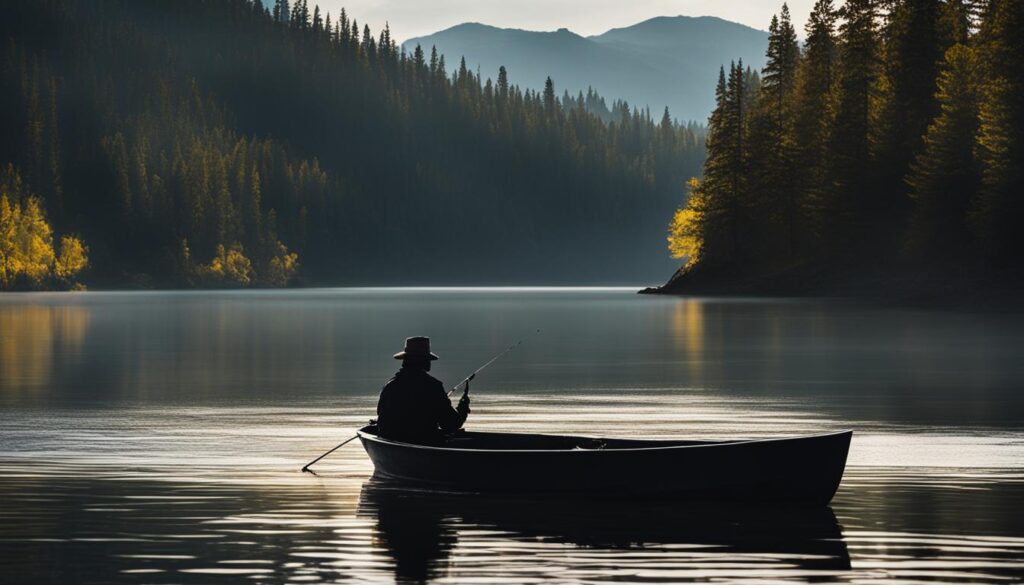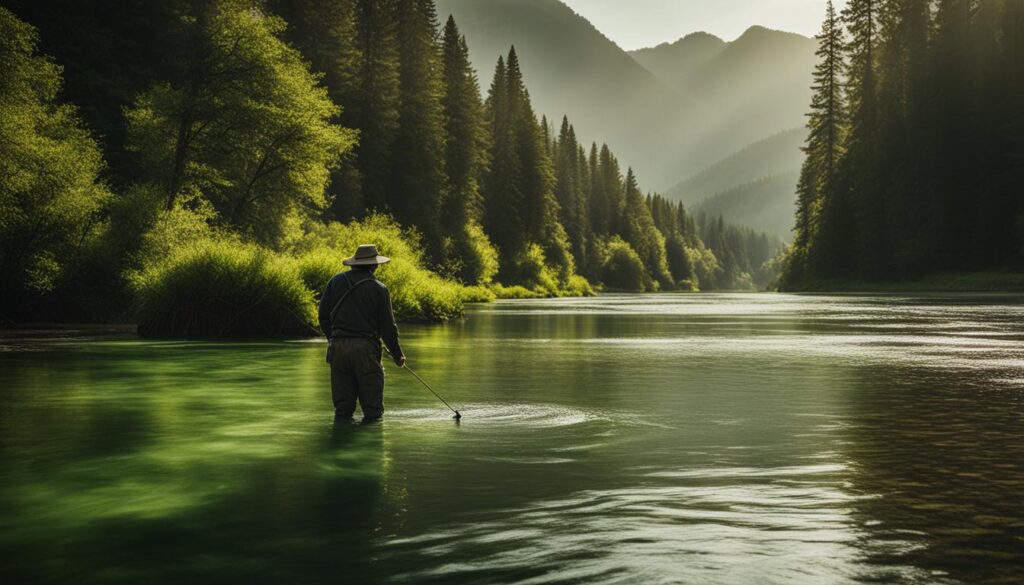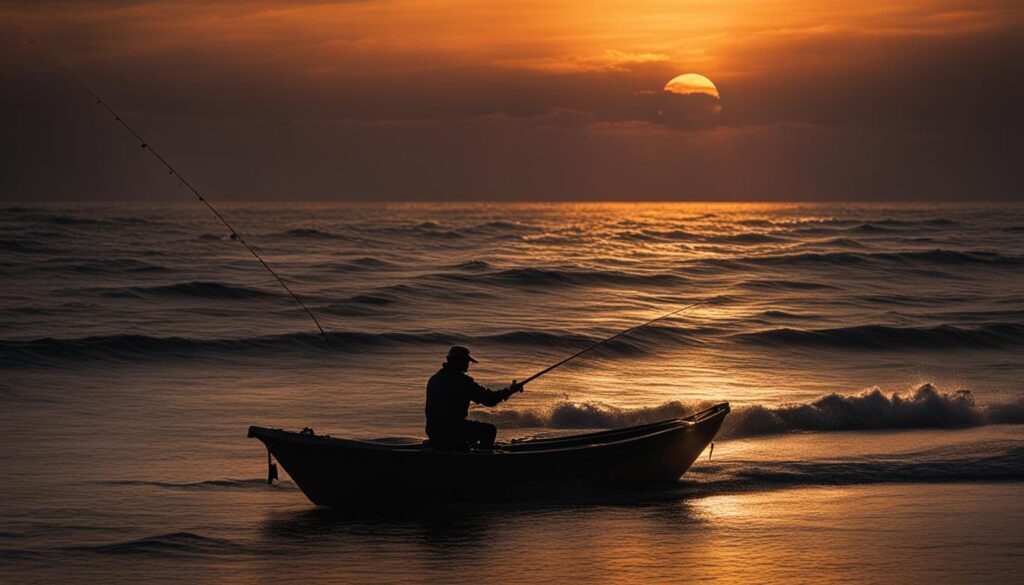We may earn money or products from the companies mentioned in this post.
If you’re planning to go fishing, it’s essential to prioritize safety and follow regulations. Fishing is an enjoyable activity, but it can be dangerous if proper safety measures are not taken. Additionally, regulations are in place to ensure sustainable fishing practices and protect the environment. In this guide, we’ll provide you with essential tips, equipment, guidelines, and rules to have a safe and legal fishing experience in the United States.
Key Takeaways:
- Adhering to fishing safety guidelines and regulations is crucial for a safe and legal fishing experience.
- Fishing safety equipment is essential for your protection while out on the water.
- Understanding fishing regulations is crucial to abide by the law and protect the environment.
- Fishing safety education and research efforts play a vital role in enhancing fishing safety practices.
- By following the tips and guidelines in this guide, you can have a safe and enjoyable fishing experience while minimizing your impact on the environment.
Understanding Fishing Regulations in the United States
If you’re planning a fishing trip, it’s essential to familiarize yourself with the fishing regulations in the United States. These regulations are designed to protect the environment, prevent overfishing, and ensure that fishing remains a sustainable activity for future generations.
The specific fishing regulations that apply to you will depend on a few factors such as the location, type of fish, and the time of year. Generally, there are rules and restrictions on the size and number of fish you can catch, as well as the methods and equipment that you can use.
Fishing Regulations and Safety Rules
Some of the most essential fishing regulations and safety rules that you should know include:
| Regulation/Safety Rule | Description |
|---|---|
| Bag Limits | Restrictions on how many fish of a particular species you can catch in a day or keep in your possession, usually based on the size of the fish. |
| Size Limits | Rules that determine the minimum and maximum size of fish you can catch and keep. These rules aim to prevent the harvest of immature fish that haven’t had a chance to reproduce. |
| Seasonal Restrictions | Rules that specify when particular fish species can be caught, usually based on the fish’s breeding and migration patterns. |
| Gear Restrictions | Restrictions on the type of fishing gear you can use, such as banning nets or longlines in certain areas to prevent accidental bycatch of non-target species. |
| Licensing Requirements | Before you go fishing, you may need to obtain a fishing license, which helps fund conservation and management efforts. Licensing requirements vary by state and can be found on the state’s fish and wildlife department website. |
These are just a few examples of the regulations and safety rules that apply to fishing in the United States. It’s essential to research the specific rules that apply to your location and type of fish before heading out on your fishing trip.
Fishing Safety Measures
In addition to following fishing regulations, there are several safety measures that you should take to ensure a safe and enjoyable fishing experience:
- Wear a life jacket, especially when fishing from a boat or in wading conditions.
- Stay aware of your surroundings, and watch out for slippery or unstable terrain.
- Bring protective gear such as sunscreen, sunglasses, and a hat to protect yourself from the sun’s harmful rays.
- Be aware of weather conditions, and avoid fishing during storms or high winds.
- Learn basic first aid skills and bring a first aid kit in case of an emergency.
By following these safety measures, you can help prevent accidents and ensure a safe and enjoyable fishing trip.
Essential Fishing Safety Tips
When heading out for a fishing adventure, keeping safety in mind is crucial to prevent accidents and injuries. Here are some essential fishing safety tips to ensure that you have a safe and enjoyable fishing experience:
- Always wear a life jacket: Regardless of your swimming ability, wearing a life jacket is essential to ensure your safety in case of an emergency.
- Beware of weather conditions: Before heading out, check the weather forecast, and avoid fishing in stormy or severe weather conditions that can make the water rough.
- Bring appropriate safety gear: Along with a life jacket, make sure to bring other essential safety gear such as a first aid kit, a whistle, a flashlight, and a fire extinguisher in case of emergencies.
- Be aware of your surroundings: Always be aware of your surroundings, including other boaters, swimmers, and potential hazards such as rocks, logs, and branches in the water.
- Check your equipment: Make sure your fishing equipment is in good condition, secure, and functioning correctly to avoid any accidents or equipment failure.
- Fish with a buddy: Fishing with a friend or family member can add another layer of safety, as you can watch out for each other and help in case of an emergency.
Note: Always follow fishing safety guidelines and regulations to prevent injuries, accidents, and environmental damage. Respect the water and the environment and leave it as you found it.
Fishing Safety Equipment for a Safe Experience
When it comes to fishing safety, having the right equipment is crucial. Not only will it keep you safe, but it can also improve your chances of having a successful fishing trip. Here are some of the essential fishing safety equipment items that you should consider bringing along:
| Equipment Item | Purpose |
|---|---|
| Life Jacket | To ensure safety in case of an accident or unexpected fall in the water. |
| First Aid Kit | To treat injuries and emergencies that may occur while fishing, such as cuts, burns, and insect bites. |
| Sunscreen and Hat | To protect your skin and eyes from harmful UV rays while spending time on the water. |
| Wading Belt | To keep your waders from filling with water and potentially causing you to drown. |
| Fishing Gloves | To protect your hands from sharp hooks or teeth on fish, as well as from the sun and cold weather. |
| Knife or Pliers | To remove hooks from fish, cut line, or other purposes, such as emergency situations. |
| Whistle | To signal for help in case of an emergency, such as if you become stranded or injured. |
Having the appropriate fishing safety equipment is not only important for your own safety but also for the safety of those around you. These items can help prevent accidents, reduce injuries, and ensure that everyone has an enjoyable and safe fishing experience.
Importance of Fishing Safety Education and Research
Fishing safety education and research are crucial components in promoting safe and sustainable fishing practices. They ensure that anglers are equipped with the necessary knowledge and skills to mitigate risks and hazards while enjoying their fishing experience. Ongoing research efforts help identify emerging safety concerns and provide evidence-based solutions to prevent accidents and injuries.
The Benefits of Fishing Safety Education
Fishing safety education programs aim to improve anglers’ knowledge of safety guidelines, regulations, and best practices. Through these programs, anglers learn how to:
- Recognize potential hazards, such as fast currents, slippery surfaces, and sharp objects
- Use safety equipment, such as life jackets, first aid kits, and emergency signals
- Properly handle and release fish to minimize harm
- Dispose of fishing gear and waste responsibly
By implementing these safety measures, anglers can protect themselves, their fellow anglers, and the aquatic environment. Fishing safety education also helps encourage responsible and ethical fishing practices, promoting sustainable fishing opportunities for future generations.
The Importance of Fishing Safety Research
Research plays a critical role in identifying safety risks and developing effective prevention measures. Studies on fishing safety cover a wide range of topics, such as:
“Fishing vessel safety and stability, drowning prevention, thermal protection, personal flotation devices, hypothermia, angler safety and boating, and water-related injuries and fatalities.”
By analyzing data and identifying trends, researchers can design targeted interventions and policies to enhance fishing safety. For example, research on the effectiveness of personal flotation devices (PFDs) led to the implementation of mandatory PFD regulations on all recreational boats in the United States.
Conclusion
In conclusion, fishing safety and regulations should be a top priority for all anglers. By following the guidelines and measures outlined in this guide, you can ensure a safe and legal fishing experience while preserving the environment.
The Importance of Compliance
Adhering to fishing regulations is essential to protect the sustainability of our fisheries. When anglers knowingly or unknowingly violate these rules, it can have a detrimental impact on the local ecosystem. By complying with regulations, you can do your part to preserve the environment for future generations.
Staying Safe on the Water
Prioritizing safety while fishing is crucial to avoid accidents and injuries. By following the tips and guidelines provided in this guide, you can minimize the risk of accidents and ensure a safe and enjoyable fishing trip.
Continuing Education
Education and research efforts are critical for promoting safer fishing practices. Learning about new safety equipment and techniques can help keep you and your fishing companions safe. Additionally, staying up-to-date on fishing regulations can help you avoid legal issues and protect the environment.
By prioritizing fishing safety and complying with regulations, you can have a successful and enjoyable fishing experience while making a positive impact on the environment.
FAQ
What are fishing regulations?
Fishing regulations are laws and guidelines put in place by government agencies to manage and protect fish populations. These regulations dictate things like which species can be caught, size limits, bag limits, and fishing seasons.
Why are fishing regulations important?
Fishing regulations are important because they help ensure the long-term sustainability of fish populations and protect the overall health of aquatic ecosystems. By following these regulations, anglers can help maintain healthy fish stocks and preserve the biodiversity of our waterways.
Where can I find fishing regulations for my area?
Fishing regulations can vary depending on the state and even specific bodies of water. It’s crucial to familiarize yourself with the regulations specific to your fishing location. You can find this information on the websites of your state’s fish and wildlife agency or by contacting them directly.
What safety measures should I take while fishing?
When fishing, it’s important to prioritize safety. Some key safety measures include wearing a properly fitted life jacket, informing someone of your fishing plans and expected return time, carrying a first aid kit, being aware of weather conditions, and practicing responsible boating if fishing from a boat.
What are some common fishing safety equipment?
Essential fishing safety equipment includes personal flotation devices (life jackets), appropriate footwear for slippery conditions, sun protection (such as hats and sunscreen), a properly stocked first aid kit, a throwable flotation device, and an emergency signaling device like a whistle or flare.
Why is fishing safety education important?
Fishing safety education is important as it helps anglers develop the necessary knowledge and skills to engage in fishing activities safely. It promotes a culture of responsible fishing practices, reduces the risk of accidents and injuries, and contributes to the overall well-being of the fishing community.
How can I contribute to fishing safety research?
While you may not actively conduct fishing safety research, you can contribute by participating in surveys and studies related to fishing safety. By providing your insights and experiences, you can help researchers better understand the challenges anglers face and identify areas where safety measures can be improved.
Affiliate Disclosure: This post may contain affiliate links. If you purchase through our link, we may receive a small commission, but at no additional cost to you. For more information, please see our Disclosure statement.



